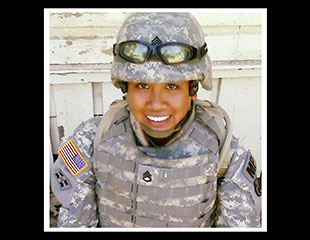Living With Chronic Pain
3-minute read
Living With Chronic Pain
3-minute read
It all began to feel like a mountain of issues.
Marie, a U.S. Army Veteran, felt like she should be excited as she returned from Iraq. She was young. She was home. But even though she remained a very social person, Marie found it hard at times to relate to people who hadn’t been in her unit. This led to a certain loneliness.
She also began to have intense nightmares, to the point that she stopped sleeping. Loud noises — jackhammers, cars, thunder — began to affect her. One night, in the middle of a thunderstorm, she leapt out of bed so quickly that she banged her head against the opposite wall.
And then there was the pain. Physical pain. Gastrointestinal issues. Crippling chest pains. “I started getting really, really sick,” Marie says. “I went from being able to run 20 miles — I’m a long-distance runner — to not even able to run two. I started having all kinds of health complications.”
She wasn’t alone.
It’s not uncommon for Veterans to face chronic pain after serving — even years later. Chronic pain is defined as pain experienced for at least three months. For some, this pain is the result of an old injury that has resurfaced with time. For others, chronic pain comes from illness or the wear and tear of aging. For others still, the source is a mystery.
Dealing with chronic pain can take a physical toll. But it can also lead to irritability, depression, and even a sense of hopelessness. The good news, though, is that there are treatment options. They include:
- Physical therapy. This can help you increase your level of pain-free activity.
- Therapy or counseling. This can help you address the way you cope with or relate to your pain.
- Relaxation and mindfulness techniques. These can help you manage the stress that may accompany chronic pain.
- Advanced medications. These can reduce the severity of pain in some cases.
If you are experiencing chronic pain, speak with your doctor, who can develop a treatment plan for you. Additional steps that you can take include:
- Learning more about your condition. The more you know about what you’re facing, the better you can decide which options are best for you.
- Keeping a “pain diary.” Record your progress with treating pain and how pain affects your life.
- Finding ways to stay physically active. Follow your doctor’s recommendations for exercise.
- Talking with your family members and friends. They can help you decide which type of pain treatment is best for you.
For Marie, it was the pain that eventually motivated her to turn to VA. “There were days,” she says, “that I was just like, ‘I don’t know what’s happening to my body.’”
Through VA, Marie signed up for a group therapy session focused on chronic pain.
"I actually liked and enjoyed [that], because I could meet up with other Vets who were in massive pain like me,” she says, with a laugh. “And then … I didn’t feel like it was just me dealing with my issues. It was, 'Hey, we are all dealing with these issues.’ And that form of therapy was kind of a breakthrough for me.”
Eventually, Marie learned that chemical exposure overseas was likely the source of her pain. She was also diagnosed with acute depression.
“I am super thankful that I did end up having the willpower to see through it and get the treatment that I needed,” Marie says. “Because now — I don’t even know how to explain — life has become a lot easier for me, because now I know what’s wrong with me.
“It’s so much easier to manage your illnesses if you’re actually willing to confront them and say, ‘Yes, I have this. And I need to go find treatment. I need to figure out what medication works for me and just do the footwork, no matter how hard it is.’”

